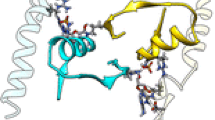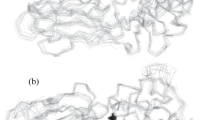Abstract
The periplasmic lysine-, arginine-, ornithine-binding protein (LAOBP) traps its ligands by a large hinge bending movement between two globular domains. The overall geometry of the binding site remains largely unchanged between the open (unliganded) and closed (liganded) forms, with only a small number of residues exhibiting limited movement of their side chains. However, in the case of the ornithine-bound structure, the backbone peptide bond between Asp11 and Thr12 undergoes a large rotation. Molecular dynamics simulations have been used to investigate the origin and mechanism of this backbone movement. Simulations allowing flexibility of a limited region and of the whole binding site, with and without bound ligands, suggest that this conformational change is induced by the binding of ornithine, leading to the stabilisation of an energetically favourable alternative conformation.









Similar content being viewed by others
References
Carlson HA, McCammon JA (2000) Accommodating protein flexibility in computational drug design. Mol Pharm 57:213–218
Carlson HA (2002) Protein flexibility is an important component of structure-based drug discovery. Curr Pharm Dis 8:1571–1578
Carlson HA (2002) Protein flexibility an drug design: how to hit a moving target. Curr Opin Chem Biol 6:447–452
Teague SJ (2003) Implications of protein flexibility for drug discovery. Nat Rev Drug Discov 2:527–541
Teodoro ML, Kavraki LE (2003) Conformational flexibility models for the receptor in structure based drug design. Curr Pharm Des 9:1635–1648
Wong CF, McCammon JA (2003) Protein flexibility and computer-aided drug design. Annu Rev Pharmacol Toxicol 43:31–35
Leach AR (1994) Ligand docking to proteins with discrete side chain flexibility. J Mol Biol 235:345–356
Totrov M, Abagyan R (1997) Flexible protein-ligand docking by global energy optimization in internal coordinates. Proteins Suppl 1:215–220
Nakajima N, Higo J, Kidera A, Nakamura H (1997) Flexible docking of a ligand peptide to a receptor protein by multicanonical molecular dynamics simulation. Chem Phys Lett 278:297–301
Schnecke V, Kuhn LA (2000) Virtual screening with solvation and ligand-induced complementarity. Perspect Drug Discov 20:171–190
Cavasotto CN, Abagyan RA (2004) Protein flexibility in ligand docking and virtual screening to protein kinases. J Mol Biol 337:209–225
Sherman W, Day T, Jacobson MP, Friesner RA, Farid R (2006) Novel procedure for modeling ligand/receptor induced fit effects. J Med Chem 49:534–553
Carlson HA, Masukawa K, McCammon JA (1999) Method for including the dynamic fluctuations of a protein in computer-aided drug design. J Phys Chem A 103:10213–10219
Pang Y-P, Kozikowski AP (1994) Prediction of the binding sites of huperizine A in acetylcholinesterase by docking studies. J Comput-Aided Mol Des 8:669–681
Knegtel RMA, Kuntz ID, Oshiro CM (1997) Molecular docking to ensembles of protein structures. J Mol Biol 266:424–440
Bouzida D, Rejto PA, Arthurs S, Colson AB, Freer ST, Gehlhaar DK, Larson V, Luty BA, Rose PW, Verkhivker GM (1999) Computer simulations of ligand-protein binding with ensembles of protein conformations: a Monte Carlo study of HIV-1 protease binding energy landscapes. Int J Quant Chem 72:73–84
Claussen H, Buning C, Rarey M, Lengauer T (2001) FlexE: efficient molecular docking considering protein structure variations. J Mol Biol 308:377–395
Osterberg F, Morris GM, Sanner MF, Olson AJ, Goodsell DS (2002) Automated docking to multiple target structures: incorporation of protein mobility and structural water heterogeneity in AutoDock. Proteins 46:34–40
Erickson JA, Jalaie M, Robertson DH, Lewis RA, Vieth M (2004) Lessons in molecular recognition: the effects of ligand and protein flexibility on molecular docking accuracy. J Med Chem 47:45–55
Källblad P, Todorov NP, Willems HMG, Alberts IL (2004) Receptor flexibility in the in silico screening of reagents in the S1’ pocket of human collagenase. J Med Chem 47:2761–2767
Todorov NP, Buenemann CL, Alberts IL (2006) De novo ligand design to an ensemble of protein structures. Proteins 64:43–59
Jiang F, Kim SH (1991) “Soft docking”: matching of molecular surface cubes. J Mol Biol 219:79–102
Gschwend DA, Good AC, Kuntz ID (1996) Molecular docking towards drug discovery. J Mol Rec 9:175–186
Ferrari AM, Wei BQ, Costantino L, Shoichet BK (2004) Soft docking and multiple receptor conformations in virtual screening. J Med Chem 47:5076–5084
Carlson HA, Masukawa KM, Rubins K, Bushman FD, Jorgensen WL, Lins RD, Briggs JM, McCammon JA (2000) Developing a dynamic pharmacophore model for HIV-1 integrase. J Med Chem 43:2100–2114
Meagher KL, Carlson HA (2004) Incorporating protein flexibility in structure-based drug discovery: using HIV-1 protease as a test case. J Am Chem Soc 126:13276–13281
Damm KL, Carlson HA (2007) Exploring experimental sources of multiple protein conformations in structure-based drug design. J Am Chem Soc 129:8225–8235
Wasserman ZR, Hodge CN (1996) Fitting an inhibitor into the active site of thermolysin: a molecular dynamics case study. Proteins 24:227–237
Di Nola A, Roccatano D, Berendsen HJC (1994) Molecular dynamics simulation of the docking of substrates to proteins. Proteins 19:174–182
Mangoni R, Roccatano D, Di Nola A (1999) Docking of flexible ligands to flexible receptors in solution by molecular dynamics simulation. Proteins 35:153–162
Najmanovich R, Kuttner J, Sobolev V, Edelman M (2000) Side-chain flexibility in proteins upon ligand binding. Proteins 39:261–268
Yang AY-C, Källblad P, Mancera RL (2004) Molecular modelling prediction of ligand binding site flexibility. J Comput Aided Mol Des 18:235–250
Murray CW, Baxter CA, Frenkel AD (1999) The sensitivity of the results of molecular docking to induced fit effects: application to thrombin, thermolysin and neuraminidase. J Comput-Aided Mol Des 13:547–562
Kang C-H, Shin W-C, Yamagata Y, Bokcen S, Ames GF-L, Kim S-H (1991) Crystal structure of the lysine-, arginine-, ornithine-binding protein (LAO) from Salmonella typhimurium at 2.7 Å resolution. J Biol Chem 266:23893–23899
Oh B-H, Pandit J, Kang C-H, Nikaido K, Gokcen S, Ames GF-L, Kim S-H (1993) Three-dimensional structures of the periplasmic lysine/arginine/ornithine-binding protein with and without a ligand. J Biol Chem 268:11348–11355
Ames GF-L (1986) Bacterial periplasmic transport systems: structure, mechanism and evolution. Annu Rev Biochem 55:397–425
Oh B-H, Ames GF-L, Kim S-H (1994) Structural basis for multiple ligand specificity of the periplasmic lysine-, arginine-, ornithine-binding protein. J Biol Chem 269:26323–26330
Quiocho FA, Ledvina PS (1996) Atomic structure and specificity of bacterial periplasmic receptors for active transport and chemotaxis: variation of common themes. Mol Microbiol 20:17–25
Nikaido K, Ames GF-L (1992) Purification and characterization of the periplasmic lysine-, arginine-, ornithine-binding protein (LAO) from Salmonella typhimurium. J Biol Chem 267:20706–20712
Flocco MM, Mowbray SL (1995) Cα-based torsion angles: a simple tool to analyze protein conformational changes. Protein Sci 4:2118–2122
Maiorov V, Abagyan R (1997) A new method for modeling large-scale rearrangements of protein domains. Proteins 27:410–424
Keskin O, Jernigan RL, Bahar I (2000) Proteins with similar architecture exhibit similar large-scale dynamic behaviour. Biophys J 78:2093–2106
Tama F, Sanejouand Y-H (2001) Conformational change of proteins arising from normal mode calculations. Protein Eng 14:1–6
Pang A, Arinaminpathy Y, Sansom MSP, Biggin PC (2005) Comparative molecular dynamics–similar folds and similar motions? Proteins 61:809–822
McLachlan AD (1982) Rapid comparison of protein structures. Acta Crystallogr A 38:871–873
Martin, A.C.R. http://www.bioinf.org.uk/software/profit/
Maple JR, Hwang M-J, Stockfisch TP, Dinur U, Waldman M, Ewig CS, Hagler AT (1994) Derivation of class II force fields 1. Methodology and quantum force field for the alkyl functional group and alkane molecules. J Comput Chem 15:162–182
Nosé S (1984) A unified formulation of the constant temperature molecular dynamics methods. J Chem Phys 81:511–519
Hoover WG (1985) Canonical dynamics: equilibrium phase-space distributions. Phys Rev A 31:1695–1697
Verlet L (1967) Computer “experiments” on classical fluids I. Thermodynamical properties of Lennard-Jones molecules. Phys Rev 159:98–103
Ryckaert JP, Ciccotti G, Berendsen HJC (1977) Numerical integration of the Cartesian equations of motion of a system with constraints: molecular dynamics of n-alkanes. J Comput Phys 23:327–341
Schaffer L, Verkhivker GM (1998) Predicting structural effects in HIV-1 protease mutants complexes with flexible ligand docking and protein side-chain optimization. Proteins 33:295–310
Frimurer TM, Peters GH, Iversen LF, Andersen HS, Moller NP, Olsen OH (2003) Ligand-induced conformational changes: improved predictions of ligand binding conformations and affinities. Biophys J 84:2273–2281
Taylor RD, Jewsbury PJ, Essex JW (2003) FDS: flexible ligand and receptor docking with a continuum solvent and soft core energy function. J Comput Chem 24:1637–1656
Acknowledgements
AYCY gratefully acknowledges De Novo Pharmaceuticals Ltd. for the award of a postgraduate scholarship. Part of this work was funded by a Strategic Research Grant from Curtin University of Technology.
Author information
Authors and Affiliations
Corresponding author
Rights and permissions
About this article
Cite this article
Yang, A.YC., Mancera, R.L. Molecular dynamics simulations of ligand-induced backbone conformational changes in the binding site of the periplasmic lysine-, arginine-, ornithine-binding protein. J Comput Aided Mol Des 22, 799–814 (2008). https://doi.org/10.1007/s10822-008-9215-6
Received:
Accepted:
Published:
Issue Date:
DOI: https://doi.org/10.1007/s10822-008-9215-6




